Disability Community Wellness and Activism
SOU Disability Resources
SOU Disability Resources
Our Disability Community is growing! At Disability Resources, we are committed to providing you with the most up to date and research based resources by providing a landing page for resources, connections and avenues for students to grow their efficacy, advocacy and activism.
Self-Advocacy and Self-Efficacy
Self advocacy and self efficacy are skills that you are learning about and building on a daily basis. Attending a university provides many exciting opportunities that will put the skills students’ already have to the test and provide many teachable moments to learn new ones!
Self-efficacy is a person’s belief in themselves or their capacity to complete a goal or task. Self-efficacy refers to an internal conversation with the self, and facing internalized biases.
Self-advocacy is the action of knowing and representing themself, or communicating their needs, limitations, or boundaries. This refers more to an external conversation of the self with others or an environment.
This is why self-efficacy and advocacy link closely together. When self-advocating to an outside force, the individual takes into account their self-efficacy, their belief in themself.
At SOU, we support building self-advocacy in our students with disabilities by providing opportunities for students to request accommodations each term, and communicating their needs with their accommodations to professors.
Our goal for all students in our disability community is to not only to grow academically, but also build up their self-efficacy and advocacy. This may be different from the support at home or in high school, and that’s okay. Self-efficacy and advocacy are skills that will continue to grow and evolve throughout a lifetime. While SOU, we want to support the growth of these skills within our students.
Equality, Equity, and Liberation at SOU
A common misconception is equality and equity being used interchangeably. But these terms have two very different meanings, especially when talking about disability and society. Below we have a Question and Answer with Former Disability Resources Coordinator Shawn Foster and current Disability Resources Coordinator Aubrey Owens discussing Equality, Equity and Liberation at SOU.
Q: Why is Equity more important than Equality?
Shawn: Equality ensures that everyone is treated the same, regardless of their circumstances or identity. However, equality does not remove barriers to access; that is the role of equity. Equity ensures everyone has a level playing field.
Aubrey: As with most civil rights issues, equality does not factor in the intersection of identities or inequities of the world. Equity does. Equity acknowledges the differences in experience and aims to provide resources needed to remove identifiable barriers.
Q: How does Disability Resources show Equity at SOU?
Shawn: Accommodations are all about equity. They are designed to allow the student to engage in their learning without the impact of disability-related barriers that exist in the physical or learning environments.
Q: How does DR strive for Liberation at the University?
Aubrey: Liberation is for DR not to exist. If we could work ourselves out of a job; if all barriers were identified and removed, that is liberation. If all of the learning and physical environments for individuals of all lived-experiences were accessible at SOU–we’ve arrived. For now, we are here and always seeking to liberate.
Shawn: Liberation is about creating spaces for students to build their success. We work with the rest of the SOU community to implement universal design and grow the understanding of differing experiences. We help students figure out their own best ways to live out their academic dreams, capitalizing on their strengths. We connect students to one another to help them form community and shared experience.
Emailing Professors about Disability
Communicating with professors over email is essential for every student, but even more so for students with disabilities. Directly communicating your needs, or accommodation usage, can be difficult because the process is stigmatized. There can be anxiety around emailing professors, as not wanting to be seen as ‘less capable or lazy.’ When students feel this way, there is a tendency to apologize for using an accommodation – which can undermine the request or statement, because disability is still stigmatized in our society. But as an individual – you do not need to apologize for having a disability or using accommodations.
This process of emailing professors is important to building your self-advocacy and efficacy. By practicing advocating for yourself in a controlled email, where you can correct your wording, you can build your ability to better express yourself in person, or outside of the college setting.
Below are a few tips for effectively communicating with professors over email to talk about disability that demonstrate strong self advocacy skills.
Email Tips
Please remember: As a disabled student registered with Disability Resources, professors do not have a right to know your disability(ies) or ask why you need your accommodation(s). It is none of their business and you have a right to privacy. Please refer professors to Disability Resources if they are asking these questions, or stating they will determine your eligibility to use your accommodation(s) in their class.
DR Calling Cards
Use and Purpose
Our DR Calling Cards are four inch square cards that may help students self-advocate while unable to verbalize their current situation, or experience. The cards allow students to communicate to others that they are okay, but are not able to talk at the moment. These cards are not accommodations, and are not meant to replace accommodations, but can be used as a tool by the SOU community.
Version One, pictured below, directly mentions a disability, with the front of the card stating:
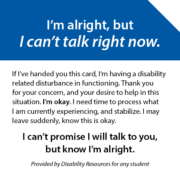
“I’m alright, but I can’t talk right now.
If I’ve handed you this card, I’m having a disability related disturbance in functioning. Thank you for your concern, and your desire to help in this situation. I’m okay. I need time to process what I am currently experiencing, and stabilize. I may leave suddenly, know this is okay.
I can’t promise I will talk to you, but know I’m alright.”
Version Two, pictured below, does not mention disability and focuses on coping mechanisms:
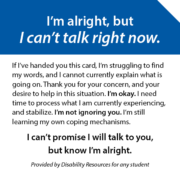
“I’m alright, but I can’t talk right now.
If I’ve handed you this card, I’m struggling to find my words, and I cannot currently explain what is going on. Thank you for your concern, and your desire to help in this situation. I’m okay. I need time to process what I am currently experiencing, and stabilize. I’m not ignoring you. I’m still learning my own coping mechanisms.
I can’t promise I will talk to you, but know I’m alright.”
Printing Directions
These cards may be available at Disability Resources, but students can also choose to print their own cards through SOU’s printshop, SOU Print and Copy. While DR would not be paying for your cost, four calling cards can be printed for around $8, charged directly to a student account.
For step by step directions for printing, please select the tab of the version to be printed below. These are print ready files to be used at SOU Print and Copy.
Printing Version One: Disability Related Disturbance
Please download this file, DR Calling Cards Version One, to your computer.
Under “Step One: Select Category” scroll down until you find “Square Cards” and select this category. You will be directed to a new page.
Under “Step 2: Select Finished Size for Square Cards” select “4×4 Square Cards” You will be directed to a new page.
Under “Step 3: Print Order Information” there are multiple fillable areas. Please fill in the following form with the information provided below.
Job Name: Student order of DR Calling Cards Version One
How many Square Cards do you Need: 4
Format: 2 sided
# Originals: 1
Ink Color: Both
Stock Style: Uncoated Cover
Stock Weight: 100#
After filling in this information, click the Continue button on the bottom of the page. You will then be directed to the next page.
Under “Step 4: Finishing” ensure that the cutting selection is “Trim to Crops” and click Continue.
Under “Step 5: Attach Files” Click Yes, and attach the downloaded pdf, DR_Calling Cards_Version One.pdf.
In the drop down menu “Select Attachment type” select “document” and click attach file.
On the last page, “Step Six: Billing and Delivery” ensure to put in your student ID number (starting in 9404….) to pay for the printing of your DR Calling Cards.
Click finish and SOU Print and Copy will send an email to your SOU.edu email when your order is ready for pick up!
Printing Version Two: Learning Coping Mechanisms
Please download this file, DR Calling Cards Version Two, to your computer.
Under “Step One: Select Category” scroll down until you find “Square Cards” and select this category. You will be directed to a new page.
Under “Step 2: Select Finished Size for Square Cards” select “4×4 Square Cards” You will be directed to a new page.
Under “Step 3: Print Order Information” there are multiple fillable areas. Please fill in the following form with the information provided below.
Job Name: Student order of DR Calling Cards Version Two
How many Square Cards do you Need: 4
Format: 2 sided
# Originals: 1
Ink Color: Both
Stock Style: Uncoated Cover
Stock Weight: 100#
After filling in this information, click the Continue button on the bottom of the page. You will then be directed to the next page.
Under “Step 4: Finishing” ensure that the cutting selection is “Trim to Crops” and click Continue.
Under “Step 5: Attach Files” Click Yes, and attach the downloaded pdf, DR_Calling Cards_Version Two.pdf
In the drop down menu “Select Attachment type” select “document” and click attach file.
On the last page, “Step Six: Billing and Delivery” ensure to put in your student ID number (starting in 9404….) to pay for the printing of your DR Calling Cards.
Click finish and SOU Print and Copy will send an email to your SOU.edu email when your order is ready for pick up!
Printing Versions One and Two
Please download this file, DR Calling Cards Versions One and Two, to your computer.
Under “Step One: Select Category” scroll down until you find “Square Cards” and select this category. You will be directed to a new page.
Under “Step 2: Select Finished Size for Square Cards” select “4×4 Square Cards” You will be directed to a new page.
Under “Step 3: Print Order Information” there are multiple fillable areas. Please fill in the following form with the information provided below.
Job Name: Student order of DR Calling Cards Both Versions
How many Square Cards do you Need: 2*
Format: 2 sided
# Originals: 2
Ink Color: Both
Stock Style: Uncoated Cover
Stock Weight: 100#
*Filling in “How many Square Cards do you need:” with two instead of four is because there are two separate cards in the pdf. Four cards will be in the final print order, two of each card.
After filling in this information, click the Continue button on the bottom of the page. You will then be directed to the next page.
Under “Step 4: Finishing” ensure that the cutting selection is “Trim to Crops” and click Continue.
Under “Step 5: Attach Files” Click Yes, and attach the downloaded pdf, DR_Calling Cards_Versions One and Two.pdf
In the drop down menu “Select Attachment type” select “document” and click attach file.
On the last page, “Step Six: Billing and Delivery” ensure to put in your student ID number (starting in 9404….) to pay for the printing of your DR Calling Cards.
Click finish and SOU Print and Copy will send an email to your SOU.edu email when your order is ready for pick up!
Disability as Identity
While general society may see disability as less, or out of the normal human experience, this is simply not true. Disability may be a part of every single hour of every day, and change the way a person experiences the world. Or disability could be a small change that may not affect too much in a person’s life. But disability is nothing to be ashamed about.
Disabilities change the way we go about the world – how we interact with our environment, education, or social interactions. The only reason it can be harder is because our world isn’t built for everyone. But I’m proud to be a student with invisible disabilities, because it changes my life every day. There is nothing wrong with me taking a different approach to life because of my disability. Does that mean that every day is great with no challenges? No. But it does mean I can help change the community around me with the help of my peers with disabilities because we can talk openly without guilt.
Marion DeVore, SOU Alumni and 2018-2020 Peer Engagement Coordinator.
When disability becomes part of identity there can be acceptance, and community. Students at SOU are able to find peers who experience the world closer to how they do, and build each other’s efficacy to cause larger community change.
That is what we are striving to create with our students at SOU, a supportive, knowledgeable disability community.
Person-First and Identity-First Language
When talking about referring to a person with a disability there is a discussion on how to phrase identifiers. Person-first language and identity-first language are the most common ways. Ultimately it is up to the individual to decide how they want to identify themself. In general, do not ask someone probing questions about their disability, just how they would like to be referred to as, or if disclosing disability is relevant. It is the individual’s choice to identify as disabled, or having a disability.
Identity-first language is a way to communicate about disabilities that places the disability-related word first; identity-first language may be seen as a way to recognize or affirm one’s identity as disabled.
Example: Disabled person, bipolar individual, EDS person, part-time wheelchair user
Person-first language is a way to communicate about disabilities that places the person first, followed by the disability or disability descriptor, so that the disability is no longer the primary, defining characteristic of an individual, but one of several aspects of the whole person.
Example: Person with a disability, individual with anxiety, person who uses mobility aids
Disability Etiquette
The United Spinal Association provides Tips on Interacting with People with Disabilities. A useful guide on inclusion for people who experience a spectrum of disabilities.
Disability Community at SOU
While the Disabled Student Union (DSU) is not an extension of Disability Resources, it is a student-run organization to provide connections for students with disabilities and allies at Southern Oregon University.
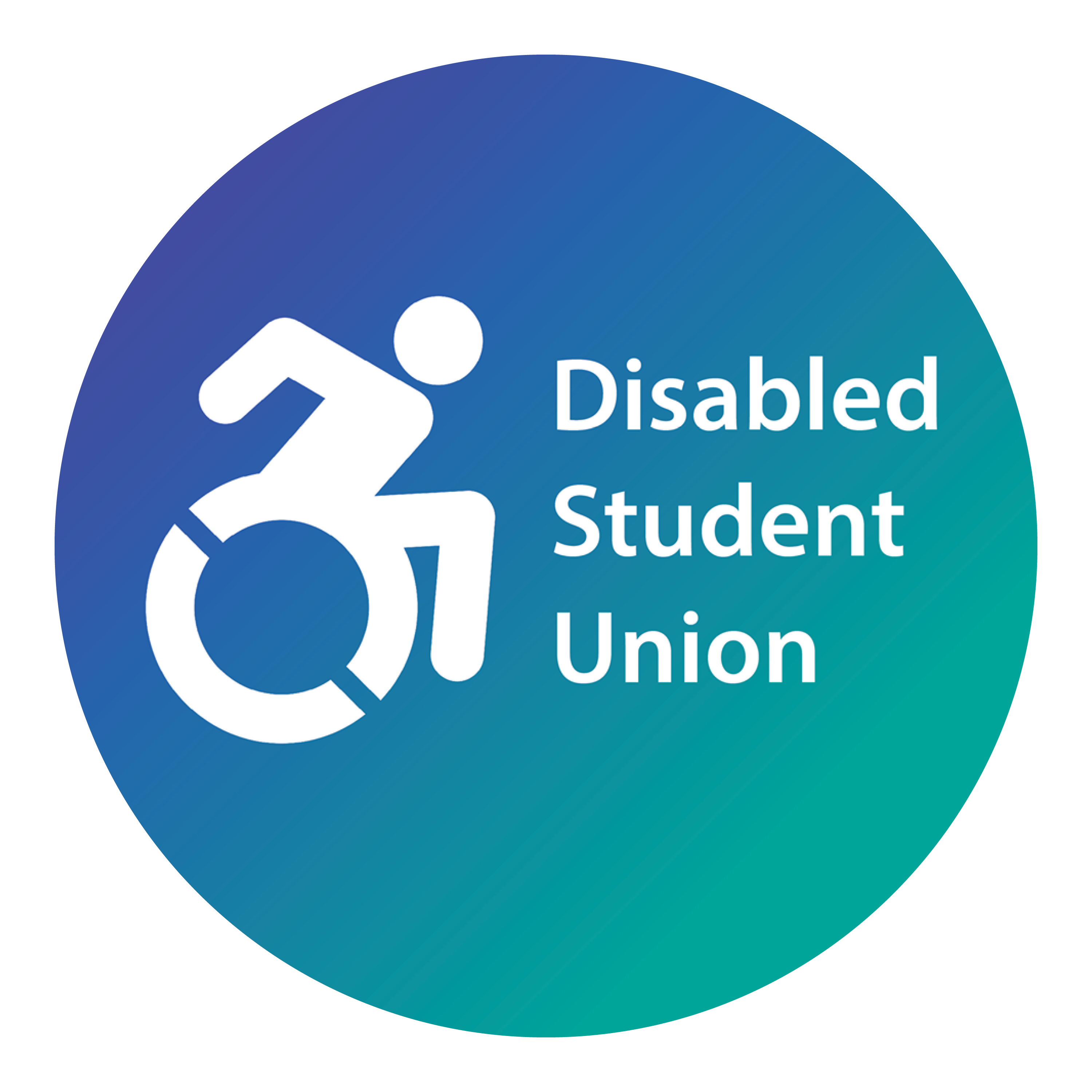
A message from DSU:
Students at large have formed together to create a student union that works to empower those with disabilities on campus. We strive to help those with disabilities, and without, to find community. We want to create a place, even virtually, where we can congregate for fun activities and discussion, as well as have a platform to fight for change on and off-campus.
Follow DSU at SOU on Twitter and Facebook!
Email DSU President
As the Student Government of Southern Oregon University, ASSOU fights for issues that matter to students on campus, in our community, in the state of Oregon, and nationally. Within ASSOU, the Accessibility Senator represents the students with disabilities within student government. The Accessibility Senator helps make descisions on campus-wide issues, formulate action plans, and vote to make changes within ASSOU and across campus as a whole.
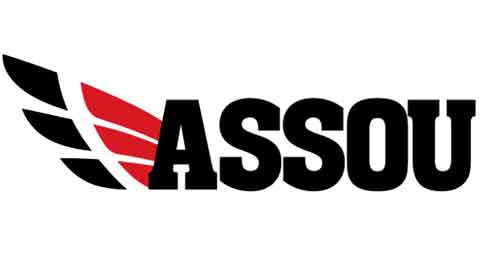
Visit ASSOU’s Accessibility Senator page to learn how to contact your Senator.
ASSOU also has opportunities to cause change on SOU’s campus. Visit Get Involved to learn more.
Know another disability-related community at SOU? Send us an email at dr@sou.edu and we can start a conversation to add them to this page.
Student Activist Projects
Disability Resources wants to showcase various activist projects done for students by students to change the culture at SOU around Disability.
Want to showcase your project? Send us an email at dr@sou.edu with the subject line: Student Activist Project.
These buttons and stickers were created for SOU students, staff, and faculty to use to increase the visibility of disability as a community and help stop the use of casual ableism.
All buttons and stickers are free for use and can be picked up at the Disability Resources Front Desk during appropriate operating hours, which can be found on our Home Page.
Stickers are 2×2″ circles with various phrases and hashtags used by the disability community to express identity and increase visibility of and destigmatize disabilities.
Invisible Disabilities Exist
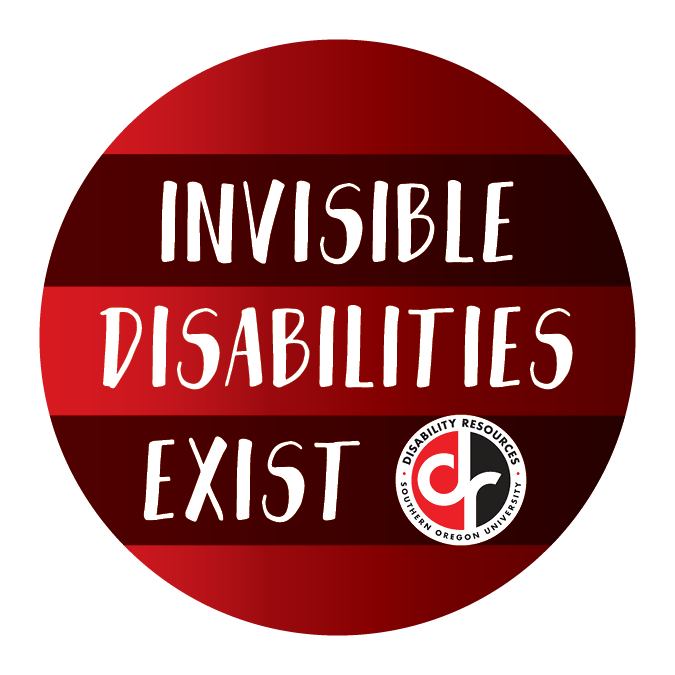
This sticker states, Invisible Disabilities Exist in white text over a Raider Red and Dark Maroon Striped background. The Disability Resources logo is anchored in the bottom right hand-side.
On SOU’s Campus many students have invisible disabilities, or disabilities that can not be recognized by simply looking at a person. This allows inclusion of those individuals who historically and societally feel “not disabled enough” to be a part of the disability community. It’s a statement made that invisibility does not equal erasure of identity.
Disrupt the Silence
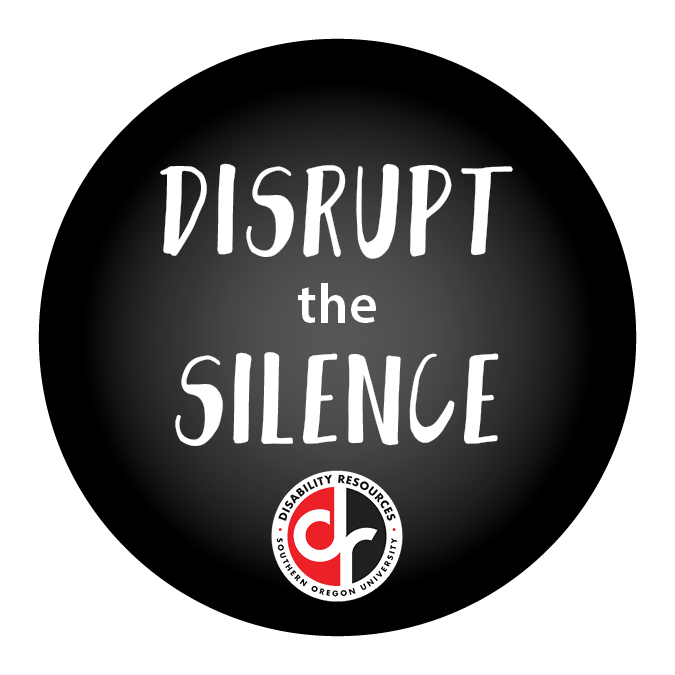
This sticker reads Disrupt the Silence in white type against a black to gray radial gradient background. The DR Logo is anchored at the bottom of the circle sticker.
Disrupt the Silence is to disrupt the silence around disability, and the lack of conversations that include disability. Do to the stigma around disability, there is hesitation to talk about disability in a way that does not alienate or tokenize the individual with a disability. This design is a commitment to talking about disability in ways that destigmatize all disabilities on our campus, without alienating our students, or ourselves.
"You Don’t Look Sick" Erases Me
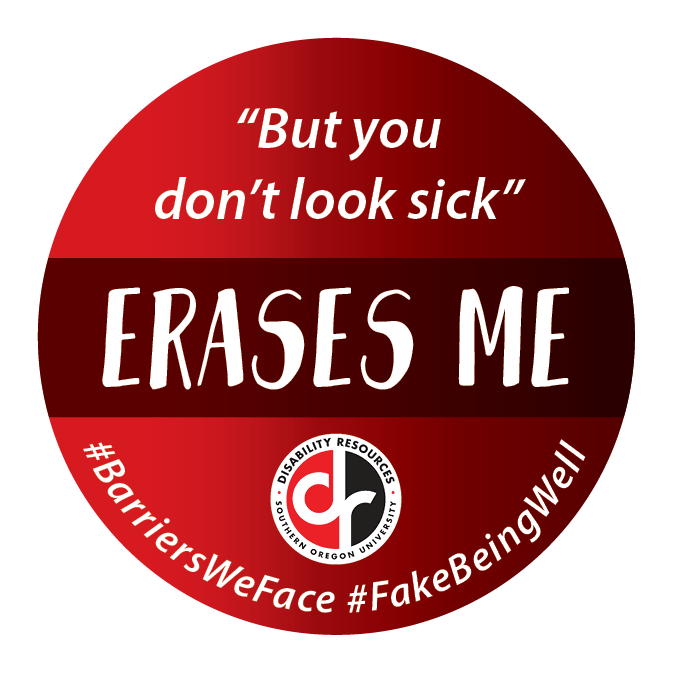
This sticker reads “But you don’t look sick” Erases Me, #Barriers We Face #Fake Being Well in white type. The background is a Raider Red with a maroon stripe across the middle, highlighting the words “Erases Me.” The two hashtags align the bottom curve of the sticker, with the DR logo in the bottom third.
Not all disabilities are visible all the time, or ever. A common experience amongst the community when discussing life with disabilities is to hear “But you don’t look sick”, “But you aren’t physically disabled”, “But you must be faking – you look fine.” This sticker is to combat these phrases. Not ‘looking disabled’ doesn’t mean a person is faking a disability. In fact it is more common for an individual to “Fake Being Well” which is why the hashtag is used here.
The Future is Accessible
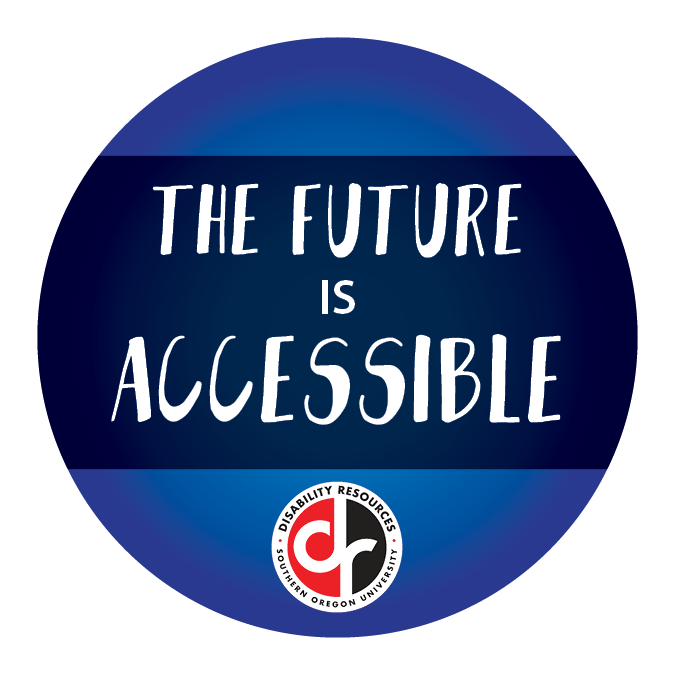
This sticker reads The Future is Accessible in white text over a disability blue background, with the text in a darker horizontal blue stripe across two thirds of the sticker. The DR logo is center anchored at the bottom of the circle sitcker.
The statement, The Future is Accessible is our commitment as a campus community to continue to become more and more acessible, and recognizing that should be our goal. To move towards universal design in our classes, campus activities, and community communication. When we keep accessibility as a core goal we include more ideas, people and experiences to broaden our university understanding.
Disability isn’t a Performance
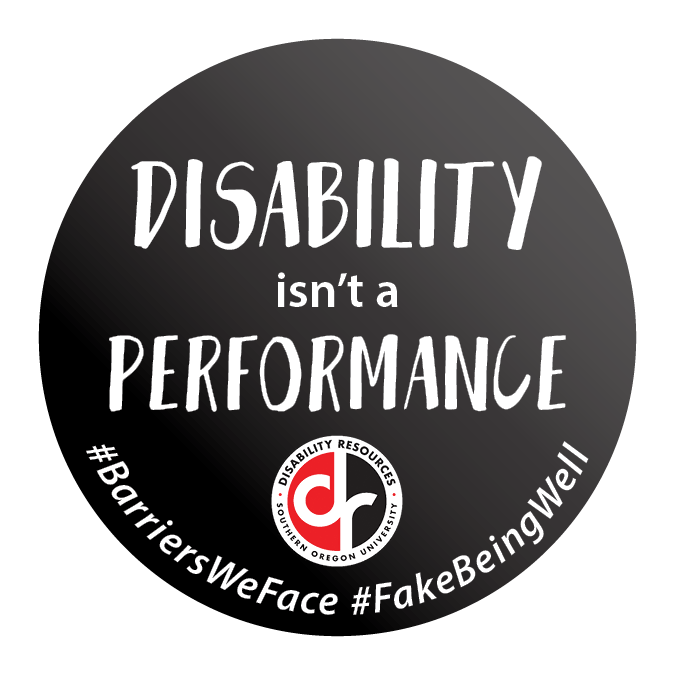
This sticker states in white text, Disability isn’t a Performance, #Barriers We Face, #Fake Being Well. The background of the sticker fades starting in the bottom right corner from a Raider Black to a lighter gray in the top left corner. The two hashtags follow the curve of the bottom of the sticker, with the DR logo centered at the bottom above the hashtags.
Disabilities are not performative, or a performance for other’s enjoyment. There are times when people with physical disabilities are asked to perform their disability, such as dislocating a joint, or streching in ways that are not considered ‘normal’ by society’s standards. These small requests or statements to display disability are leftover from the Victorian Era “freak shows” in which individuals with disabilities were used for entertainment because of their abnormalities (Bone)*. By understanding the history of these requests, we can start to break down the stigma and ideology that physical disabilities are something for entertainment or performative.
#Spoonie, Spoon Theory
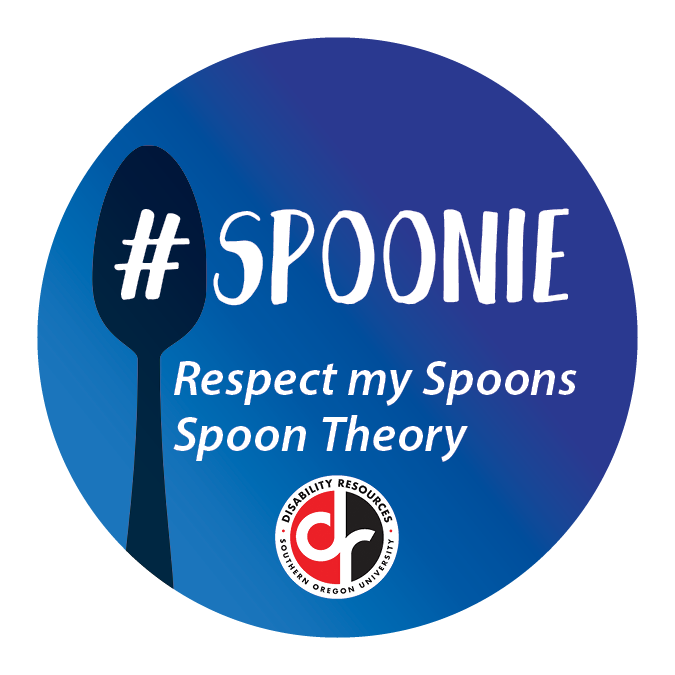
This sticker states in white text #Spoonie, Respect my Spoons, Spoon Theory. There is a dark blue shilouette of a spoon vertically holding the hashtag in the bowl of the spoon. From top right to bottom left there is a gradient from dark blue to disability blue. The DR logo is anchored in the bottom center.
Spoon Theory, created by Christine Miserandino, is a way for individuals with disabilities to explain their energy level, or capasity to complete mental, physical or emotional tasks in a tangible way to others with and without disabilities. While Spoon Theory is specific to physical disabilities, it can also be related to emotional, mental and learning disabilities. Those who use Spoon Theory may describe themselves as ‘Spoonies’ which is why #Spoonie is the main word on this button. By stating “Respect my Spoons” we are stating respect my decisions and my ability to go about the world.
Miserandino, Christine. “The Spoon Theory.” But You Dont Look Sick? Support for Those with Invisible Illness or Chronic Illness, 26 Apr. 2013, butyoudontlooksick.com/articles/written-by-christine/the-spoon-theory/.
Designs include extra space to be pressed on a 2.5″ metal button. Buttons to be used by students and campus community to express identity, and help with communication.
Invisible Disabilities Exist

This button states, Invisible Disabilities Exist in white text over a Raider Red and Dark Maroon Striped background. The Disability Resources logo is anchored in the bottom right hand-side.
On SOU’s Campus many students have invisible disabilities, or disabilities that can not be recognized by simply looking at a person. This allows inclusion of those individuals who historically and societally feel “not disabled enough” to be a part of the disability community. It’s a statement made that invisibility does not equal erasure of identity.
Disrupt the Silence

This button reads Disrupt the Silence in white type against a black to gray radial gradient background. The DR Logo is anchored at the bottom of the circle sticker.
Disrupt the Silence is to disrupt the silence around disability, and the lack of conversations that include disability. Do to the stigma around disability, there is hesitation to talk about disability in a way that does not alienate or tokenize the individual with a disability. This design is a commitment to talking about disability in ways that destigmatize all disabilities on our campus, without alienating our students, or ourselves.
The Future is Accessible

This Button states, The Future is Accessible in white text over a 45 degree dark maroon stripe that covers three-fourths of the button. On either side of the dark maroon red stripe is a raider red gradiant to a darker read. The Disabiltiy Resources is anchored in the bottom center of the button.
The statement, The Future is Accessible is our commitment as a campus community to continue to become more and more acessible, and recognizing that should be our goal. To move towards universal design in our classes, campus activities, and community communication. When we keep accessibility as a core goal we include more ideas, people and experiences to broaden our university understanding.
Can’t Talk Right Now
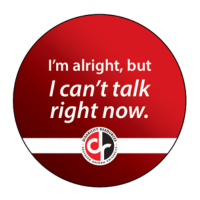
This button reads I’m alright, but I can’t talk right now in white text against a dark red to Raider Red 45 degree gradiant from bottom right to top left. The Disability Resources Logo in anchored bottom center with a white horizontal stripe behind the logo.
The button is meant to work in with our DR Calling Cards, but may be used seperately. By wearing this button, individuals have the ability to communicate non-verbally that they are okay, but can not talk. This allows for further self-advocacy and building the ability to say no, or not right now, when in a disability related disturbance or a low spoon day (see tab on Low Spoon Day for explaination). The use of red in this context is to signal a ‘hard stop.’
Low Spoon Day
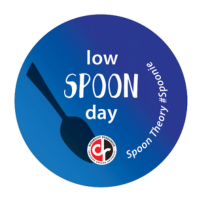
This button states in white text low spoon day. There is a dark blue shilouette of a spoon at a 45 degree angle pointing downard under the word day. In white text along the right curve of the button reads Spoon Theory, #Spoonie. From top right to bottom left there is a gradient from dark blue to disability blue. The DR logo is anchored in the bottom center.
Spoon Theory, created by Christine Miserandino, is a way for individuals with disabilities to explain their energy level, or capasity to complete mental, physical or emotional tasks in a tangible way to others with and without disabilities. While Spoon Theory is specific to physical disabilities, it can also be related to emotional, mental and learning disabilities. By an individual stating they are having a ‘low spoon day’ they may mean they don’t have as much energy as they would normally, or it is an exhausting day. Those who use Spoon Theory may describe themselves as ‘Spoonies’ which is why #Spoonie is on the round of the button.
On this page, concepts discussed above may be new, or confusing. Within conversations we have as a community on the SOU Campus around disability we wanted to provide some definitions or introductions to concepts to help build knowledge.
Videos and TED Talks
Here is a selection of some videos around disability.
SOU Accessibility Policies
Invisible Disability Project
The Invisible Disability Project, a nonprofit, created Words Matter, a glossary of disability related terminology that is an academic resource.
Best Colleges Student Accessibility Series
Best Colleges, an outside online resource, created a Student Accessibility Series to provide students with disabilities further information, outside the scope of one particular institution.
Overview of College Resources for Students with Disabilities
Discusses Legal Rights of a Disabled Student, limitations of the law, as well as the larger national grievance process. Also includes a list of apps or websites that may aid self-advocacy for students with various disabilities.
Accessing Disability Resources as a College Student
Please note our process may differ from the general overview presented in this article.
Financial Aid and Scholarship Opportunities for Students with Disabilities
A list of various disability related scholarships and websites about resources for each disability listed.
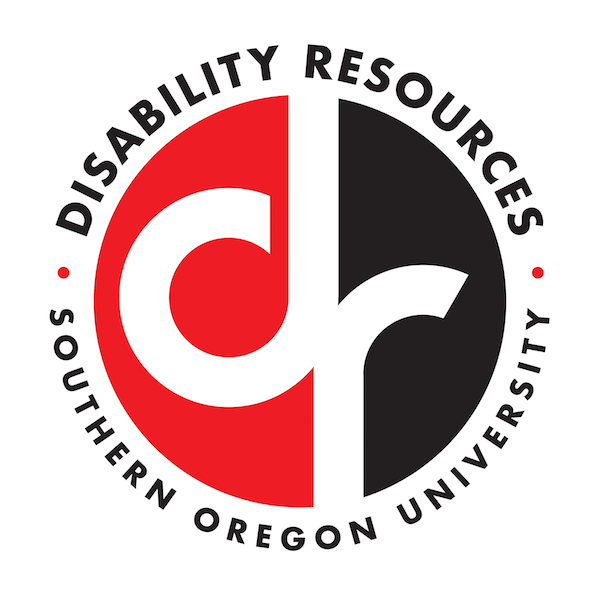
Feel like there is a gap in the information on this page?
Send us an email at dr@sou.edu to start a conversation.